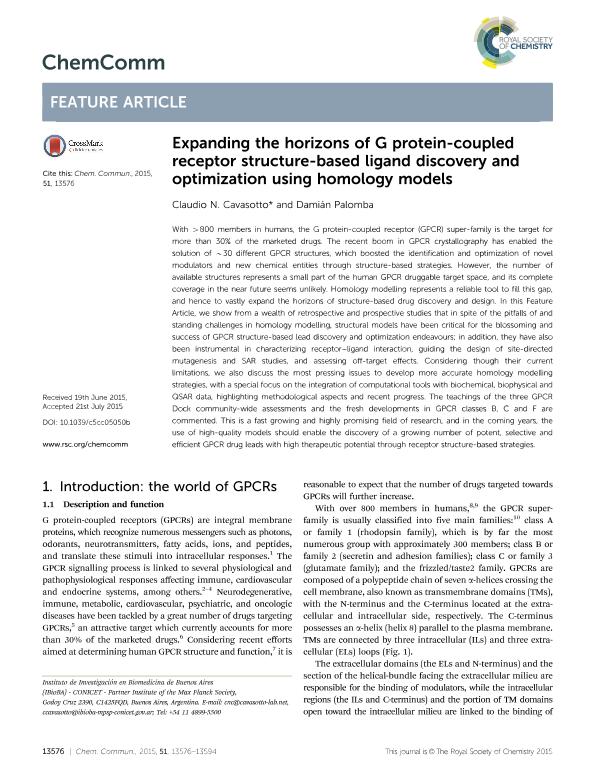Mostrar el registro sencillo del ítem
dc.contributor.author
Cavasotto, Claudio Norberto

dc.contributor.author
Palomba, Damián

dc.date.available
2018-05-30T18:39:44Z
dc.date.issued
2015-07
dc.identifier.citation
Cavasotto, Claudio Norberto; Palomba, Damián; Expanding the horizons of G protein-coupled receptor structure-based ligand discovery and optimization using homology models; Royal Society of Chemistry; Chemical Communications; 51; 71; 7-2015; 13576-13594
dc.identifier.issn
1359-7345
dc.identifier.uri
http://hdl.handle.net/11336/46697
dc.description.abstract
With >800 members in humans, the G protein-coupled receptor (GPCR) super-family is the target for more than 30% of the marketed drugs. The recent boom in GPCR crystallography has enabled the solution of ∼30 different GPCR structures, which boosted the identification and optimization of novel modulators and new chemical entities through structure-based strategies. However, the number of available structures represents a small part of the human GPCR druggable target space, and its complete coverage in the near future seems unlikely. Homology modelling represents a reliable tool to fill this gap, and hence to vastly expand the horizons of structure-based drug discovery and design. In this Feature Article, we show from a wealth of retrospective and prospective studies that in spite of the pitfalls of and standing challenges in homology modelling, structural models have been critical for the blossoming and success of GPCR structure-based lead discovery and optimization endeavours; in addition, they have also been instrumental in characterizing receptor–ligand interaction, guiding the design of site-directed mutagenesis and SAR studies, and assessing off-target effects. Considering though their current limitations, we also discuss the most pressing issues to develop more accurate homology modelling strategies, with a special focus on the integration of computational tools with biochemical, biophysical and QSAR data, highlighting methodological aspects and recent progress. The teachings of the three GPCR Dock community-wide assessments and the fresh developments in GPCR classes B, C and F are commented. This is a fast growing and highly promising field of research, and in the coming years, the use of high-quality models should enable the discovery of a growing number of potent, selective and efficient GPCR drug leads with high therapeutic potential through receptor structure-based strategies.
dc.format
application/pdf
dc.language.iso
eng
dc.publisher
Royal Society of Chemistry

dc.rights
info:eu-repo/semantics/openAccess
dc.rights.uri
https://creativecommons.org/licenses/by-nc-sa/2.5/ar/
dc.subject
G Protein-Coupled Receptor
dc.subject
Structure-Based Drug Discovery And Design
dc.subject
Homology Modelling
dc.subject.classification
Medicina Química

dc.subject.classification
Medicina Básica

dc.subject.classification
CIENCIAS MÉDICAS Y DE LA SALUD

dc.title
Expanding the horizons of G protein-coupled receptor structure-based ligand discovery and optimization using homology models
dc.type
info:eu-repo/semantics/article
dc.type
info:ar-repo/semantics/artículo
dc.type
info:eu-repo/semantics/publishedVersion
dc.date.updated
2018-05-23T16:34:07Z
dc.journal.volume
51
dc.journal.number
71
dc.journal.pagination
13576-13594
dc.journal.pais
Reino Unido

dc.journal.ciudad
Cambridge
dc.description.fil
Fil: Cavasotto, Claudio Norberto. Consejo Nacional de Investigaciones Científicas y Técnicas. Oficina de Coordinación Administrativa Parque Centenario. Instituto de Investigación en Biomedicina de Buenos Aires - Instituto Partner de la Sociedad Max Planck; Argentina
dc.description.fil
Fil: Palomba, Damián. Consejo Nacional de Investigaciones Científicas y Técnicas. Oficina de Coordinación Administrativa Parque Centenario. Instituto de Investigación en Biomedicina de Buenos Aires - Instituto Partner de la Sociedad Max Planck; Argentina
dc.journal.title
Chemical Communications

dc.relation.alternativeid
info:eu-repo/semantics/altIdentifier/url/http://pubs.rsc.org/en/content/articlelanding/2015/cc/c5cc05050b
dc.relation.alternativeid
info:eu-repo/semantics/altIdentifier/doi/http://dx.doi.org/10.1039/c5cc05050b
Archivos asociados
